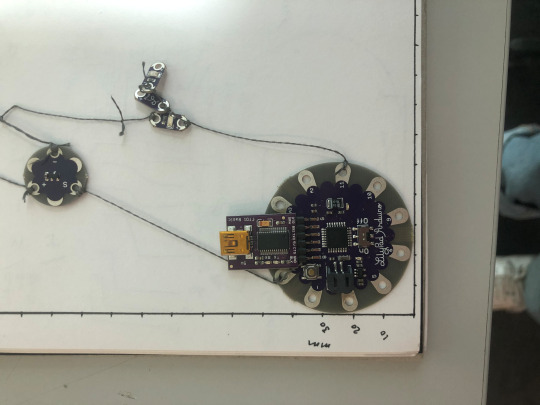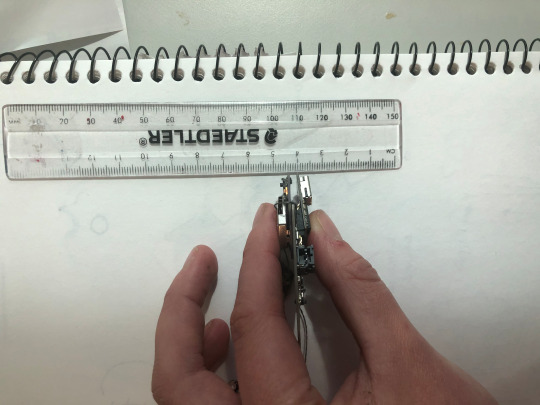Don't wanna be here? Send us removal request.
Text
Desk building on CAD
I have finally got to the point where I can kinda make something on cad! which is so cool and im really enjoying!
Here are my progress pics of my lap desk so far


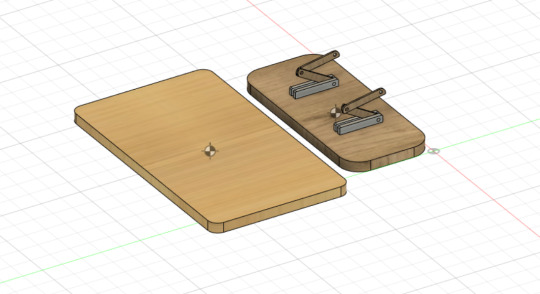
Super Satisfying getting these holes together exactly..


Through out this making I have learnt about Hinges and their properties and the mechanics that make them work! So now I am onto actually making bushings and bolts on CAD that will work best with the mechanics of this desk.
The two main ones I will be using is;
Revolute: - for the arms from the bass to the main desk
Slider: - This hinge will word for the back where the computer stand will be.
This is how far I have gotten today with the whole process which I am very happy with, and hopefully in the next few days this will really come together!
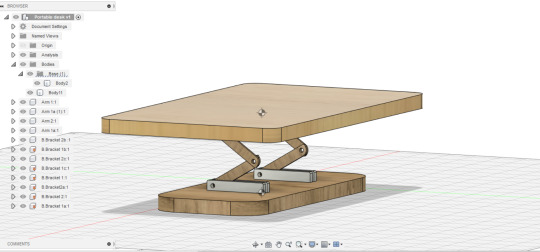
3 notes
·
View notes
Text
Adjust
After talking to Claudine about ‘challenging’ the classroom she brought up the idea of bringing an aspect of covid into this either by research or a portable item of the classroom. As I was already thinking about a desk I started to think about light weight options of portable desks. The options that are already in are chunky, hard to assemble or just gross looking



https://www.youtube.com/watch?v=xuPj4yHjbb4
https://www.youtube.com/watch?v=6wlwGz1d7CM
The vibe that I’m going for


1 note
·
View note
Text
Do you fidget?
Asked my mates do they fidget at a desk when they are trying to concentrate. The overall answer is YES
- “I like playing with Bluetac when I’m studying at my desk”
- “I doodle”
- “I play with my earrings”
- “I always play with something squishy!”
- “ I am always flicking my pen around my fingers”
Although 20 year old's wouldn’t be my target audience, there is still insight as to everyone who replied said yes to the question.
In the classroom already
What is out there to stimulate kids that are always overstimulated from excessive screen use, who then find it hard to focus on one task at a time?

Wobble cushions - First made for exercise, these balance disks have now been used as Sensory cushion. They have been shown to be an “unobtrusive and effective tool to help kids who can’t stay still and focused in the classroom be more engaged and focused on their tasks”.
(https://yourkidstable.com/wobble-cushion/)

Pedal Desks - “ The pedal desk is a novel idea because it allows a child to fidget without creating a distraction. "In the past, when your teacher told you to sit still, stop fidgeting, and do your arithmetic, it was simply the way we all did it,” Lease says. "What your teacher should have said was ‘Let’s all get up, move around, and solve that division problem.’ What the research shows is that movement in the classroom enhances cognitive learning."
(https://www.bicycling.com/training/a20044563/move-over-standing-desks-kids-learn-better-with-pedal-desks/)
6 notes
·
View notes
Text
2021 Covid free?
Can we have no more lockdowns pls
Okay getting back into it! I have had a run of a few ideas.
Do I go down the medical route again? Solve a world issue? personal or work related?
I’ve been thinking about how to drive customer service staff to work hard and gain recognition.
Ive been thinking about medical devices.
But then I saw this video (https://www.youtube.com/watch?v=vkLYXPGF8M4) and I think i have settled thus far on a broad but interesting topic.
How can the traditional classroom be challenged to adapt to modern children?
Where to go from here?
Well, there is an abundance of research on traditional schooling to delve into.
And there is alot surrounding the I generation, the impacts to concentration and multitasking. -
How far can interactive-ness be pushed in a classroom and where is it needed more? Just at the desk?
READS
http://www.ascd.org/publications/educational-leadership/feb11/vol68/num05/Teaching-the-iGeneration.aspx
https://link.springer.com/article/10.1007/s10734-014-9742-0
4 notes
·
View notes
Text
TCCP HandIN
1. Choose an example of tech to talk about. Something you’re working on in studio or an example in an area of tech that interests you.
NFC = Near Field Communication
2. Discuss the related instrumental and the intrinsic qualities of your tech example.
Instrumental definition Near-field communication (NFC) is a short-range wireless connectivity technology that lets NFC-enabled devices communicate with each other.
Intrinsic qualitites. As NFC technology is relatively new the intrinsic qualities so far are few but the possibilities with the technology are endless. From education to shopping, NFC may as well be in the definition of convenience, the possibility to create further ease of finding or producing information in these areas are immense. But may create a further demand for instant gratification and patient may become a thing of the past if the technology is taken on board throughout our society.
3. Discuss the different systems that contextualise your example of tech – technical, ecological, socio-political, economic etc
Technically NFC builds on RFID which was first patented in 1983. A technology that sends a wireless read only frequency. Unlike RFID (which credit cards use) NFC is not just read only but goes two ways, Once two devices are linked, they exchange data over the unlicensed 13.56 MHz radio spectrum. This means technology like payWave can send the receipt straight back to the phone and instantly connect with the bank provider.
NFC was approved as an ISO/IEC standard in 2003. But is still a very new technology in which we are just at the beginning of its ability
Economically NFC is an example of technology that could be made accessible to any socio-economic class or group as the price to make NFC chips is very low. NFC tags are small radio modules costing roughly 10 US cents to make each. Although they are more expensive to make than a barcode of QR code, there is much more ability and development that can be produced through and with the NFC chip. Ecologically to implement NFC into everyday life could cut out many other costs, and the need to produce plastic bank cards and transfer all forms of money into online transactions through NFC.
The constant use of NFC may create a
Culture NFC depicts no cultural reference specifically but ethical issues may directly relate to culture in society.
4. Highlight any ethical issues related to your tech example.
- Cashless Society
- Hacking
- Privacy – precise tracking of shopping and purchase habits.
Marketing agengys can then go on to use this information to create algorithms to develop hyper targeting marketing techniques (tailored marketing)
(https://cs.stanford.edu/people/eroberts/courses/cs181/projects/2010-11/NFCChips/ethics.html)
Script
Near-field communication (NFC) is a short-range wireless connectivity technology that lets NFC-enabled devices communicate with each other.
Instrumental qualities include the enhancement of connectivity. NFC requires much less power than Bluetooth and only requires one- tenth of a second to establish a connection as it automatically pairs to another NFC device. Making connections like paying with tap and go much more seamless.
As NFC technology is relatively new the intrinsic qualities so far are few but the possibilities with the technology are endless. From education to shopping, NFC may as well be in the definition of convenience. The possibility to create further ease of finding or producing information in these areas are immense. But may create a further demand for instant gratification and patient may become a thing of the past if the technology is taken on board further throughout our society.
Technically
NFC builds on RFID which was first patented in 1983. A technology that sends a wireless read only frequency. Unlike RFID, NFC is not just reed only but goes two ways, once two devices are linked, they exchange data over the unlicensed 13.56 MHz radio spectrum. This means technology like payWave can send the receipt straight back to the phone and instantly connects with the bank provider. This aspect of NFC reflects the system of information theory as it is information and data that is being process and extracted to create guidelines and boundaries within the new tech.
NFC was approved as an ISO/IEC standard in 2003. But is still a very new technology in which we are just at the beginning of its ability. A cybernetics perspective would be used to analyse this technology as the system has a goal, the system then acts and aims towards that certain goal. NFC reflects this as you can program it to complete certain actions for example, take you to a certain web page. Feedback can then be returned to the device.
Economically
NFC is an example of technology that could be made accessible to any socio-economic class or group as the price to make NFC chips is very low. NFC tags are small radio modules costing roughly 10 US cents to make each. Although they are more expensive to make than a barcode or QR code, there is much more ability and development that can be produced with the NFC chip.
NFC reflects our economic status and is a privilege to have. It is not a necessity in life, therefore countries and those who use it are displaying their privilege in life. Third world countries may not have NFC because it is not a priority of resources or use of money.
Ecologically to implement NFC into everyday life could cut out many other costs, and the need to produce plastic bank cards and transfer all forms of money into online transactions through NFC. NFC has the potential to go eco-friendly and offset many companies carbon footprints. An example of this is Idnetic Inc. Who announced earlier in the year they were producing eco friendly NFC tags. Focused on a safe IoT market for environmentally conscious companies.
There is also the opportunity for companies to use NFC to check the carbon footprint of goods through an NFC device, which could be a game changer in consumer behaviour and holding companies liable for their procedures.
Culture
NFC depicts no cultural reference specifically, but ethical issues may directly relate to culture in society. This links into Network theory throughout understanding the ethical implications of NFC as social concern around data privacy arises.
Precise tracking of shopping and purchase habits have become an issue with NFC, where marketing agencies have gone on to use customer information to create algorithms to develop hyper targeting marketing techniques (tailored marketing). These tailored marketing tactics start to impact the way people form social groups and spread information. Advertising can present clothes we like to information about the people we vote for as explained in ‘the social dilemma’. This is a huge ethical issue surrounding NFC, especially in a time when our data is not as secure as we like to think it is.
This then leads onto the privacy issues that information sharing. From where the safeguards lie in regards to protection from hackers, to how accessible our information on these devices are to the general public. The only security is offered through the official NFC ‘N-Mark’ group who standardise how the information is used and shared. This group is sponsored by Apple, Google, Samsung, Visa and other tech giants around the world.
Will any of these implications change the way we see customer service? Or impact related fields of work? Only time will tell.
0 notes
Photo

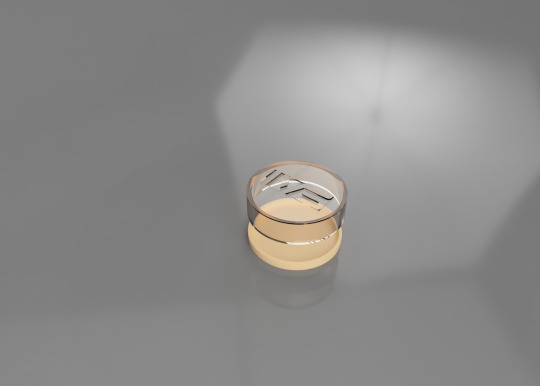
Starting to look at rendering on fusion 360 for the studio project.
The possibility to print may have been left too late but my fusion abilities are still growing.
I have been researching ideas around snaplocking on a circular box and different textures that can be used, also implementing the logo on the top.
Ill next look at where the holes for the wires will go and where the battery can be replaced.
There are lots of versions on arduino and raspberry pi cases which have been good reference points but finding one for a lilypad has been difficult as the whole point of the lily pad is to sewn on it the material.
Having the actual computer chip modular might just have to stay on the blue sky side of things at this point as time is running out, but i have done enough research for it to be easily transitioned into.
1 note
·
View note
Text
TCCP Sound
What SOUND DOES
Suggest a mood, evoke a feeling • set a pace • indicate a geographical locale • indicate a historical period • clarify the plot • define a character • connect otherwise unconnected ideas, characters, places, images, or moments • heighten realism or diminish it • heighten ambiguity or diminish it • draw attention to a detail, or away fromit • indicate changes in time • smooth otherwise abrupt changes between shots orscenes • emphasize a transition for dramatic effect • describe an acoustic space • startle or soothe • exaggerate action or mediate it The sound might be doing several of these things at once.
I want to use sound in my video to bring in the mood and evoke a feeling.
Feelings i want to bring in would be nostalgia, and the feeling of homelyness.
Maybe even the feelings we have around summer as this is a time that we video alot.
It will be smooth and i can also play on the idea of sounds around the technology used from the camera type to the way it is watched, VHS to dvd to just on a computer. The basic music samples that vloggers use on youtube to play along with these ideas.
0 notes
Text
Exciting oppourtunity
I just had an exciting chat with mum. She talked to Nigel the main pediatric cardio surgeon at the Auckland hospital who will get us in touch with one of the doctors who is in the children ICU units for checking vitals, so we are able to talk to them and ask some questions. I think it would be an incredible opportunity
0 notes
Text
Modular Designs
Modular design, or modularity in design, is a design theory and practice that subdivides a system into smaller parts called modules (such as modular process skids), which can be independently created, modified, replaced or exchanged between different systems.
Modular Shapes

Implementing CAD
I’m very new to Cad so learning along the way but am able to make the basic shapes that these modular design often use.
The initial idea are having a fun element especially considering it is to do with children.
I was thinking these shapes look similar to superhero's emblems such as Super man or Iron Mans arc reactor in End Game. This could be a fun component.






0 notes
Text
CCT WK 5: Formative Submission
WEEK 1: Auckland Art Gallery
https://ellaoconnellbiddlecombe.tumblr.com/post/626764341238202368/cct-w1-auckland-art-gallery
WEEK 2: Tautai Gallery
https://ellaoconnellbiddlecombe.tumblr.com/post/627575141088591872/cct-w2-tautai-gallery
WEEK 3: IoT
https://ellaoconnellbiddlecombe.tumblr.com/post/627556084881702912/iot
WEEK 4: Ethics
https://ellaoconnellbiddlecombe.tumblr.com/post/627584608640303104/cct-wk-4-ethics
WEEK 5: WRITTEN FORMATIVE SUBMISSION
https://ellaoconnellbiddlecombe.tumblr.com/post/627584727397924864/wk-5-cct-technology
VIDEO: https://vimeo.com/user96141377/review/452145763/fbf664e537
0 notes
Text
Wk 5 CCT: Technology
Instrumental notion of technology a means to an end – it helps us DO something specific
Intrinsic notion of technology mediates our perception of the world.
FORMATIVE
1. Discuss the cultural context of something in your blog
Within my second blog post from the Tautai Gallery. The first artwork Ake, Ake, Ake. By Israel Randell.

Depicts a strong cultural context of pacifica and the ocean. Through colour and the aura of light that has strong correlations to Moana and the history of Polynesian navigation, especially surround navigation by the stars.
Using a sense of urban landscaping through wire sculpting that the LED’s are on may also signify the culture of rope weaving. “Creating a space where one can experience Matauranga Māori (knowledge).”
2. What are intrinsic vs instrumental notions of technology. Use an example from your blog.
Instrumental notions of technology rely on having a means to an end. Something that helps us do something that is specific. In my Internet of Things blog, The smart city; automatic parking is an example of Instrumental notion. It’s means to an end is to make the process of parking much simpler and straight forward process.

Intrinsic notions of technology rely on the perception of educating and not just having a means to an end. An example of this in my blogs would be through Naawie Tutugoro’s “Come make my dreams” Through the technology that she is using, which is Hair curlers she has redefined the way someone may look at or perceive hair curlers which is how she has used them to highlight the discrimination and invisibility over Pacifica/African hair and growing up with Afro hair. Becoming to love their hair in any style and developing their own hair journey. PoC hair representation is so important as it represents value and freedom.
When PoC people were enslaved, they were made to feel less than human. Hygienic items, suitable grooming supplies, and presentable clothing were often hard to come by, if not restricted altogether. When slavery was abolished in 1865, black people were finally able to present themselves in a way that made them feel valuable. Over the years, presentation has kept its significance within African American and Pacific culture and becomes even more important since being through a time when they were controlled.

3. In regards to your engagement in your course of study, what sort of technologies are you interested in developing? (one example if you have multiple)
The technology that I am interested in developing would be through VR, with both an intrinsic and instrumental notion.
I would love to create a program that has a mean to an end and is built for a purpose but also teaches its user on a certain perception of the world through education but also possibly through the irony of it even having a means to an end.
VR has a sort of irony in itself that we have a whole world that we have lived in without technology for thousands of years but we still look for alternative ways of living. Even through games, we want open world games so it can reflect our own world but many prefer living through the game rather than doing things themselves.
4. What systems does your tech example rely on or engage with?
Technically and Environmentally, the technology of VR relies heavily on OOP (Object Orientated Paradigm). As it is important in all parts of development in the software.
Socially VR runs much more as Actor-network as in some peoples view VR has no space in their mind or any of their relationships therefore is not a conscious realm. On the other hand it may be as consuming as the real world and takes up a lot more conscious space, therefore affecting the network on a much larger scale.
5. What ethical ‘issues’ might be relevant to your example?

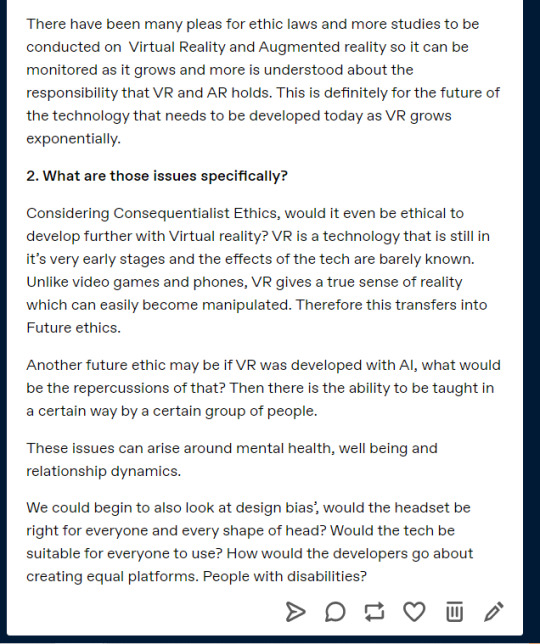
0 notes
Text
CCT WK 4: ETHICS
1. What areas in your field of interest or usage in regards to technology, that you can identify potential current or future ethical or design bias issues? (identify at least one)

In the VR field there are many ethical dangers that can arise.
“Traditional moral responsibilities do not always translate to the digital world. One aspect we argue is essential to ethical responsibility for virtual reality is that VR solutions must integrate ethical analysis into the design process”
- https://technologyandsociety.org/virtual-reality-ethical-challenges-and-dangers/#:~:text=Traditional%20moral%20responsibilities%20do%20not,practice%20dissemination%20of%20best%20practices.
There have been many pleas for ethic laws and more studies to be conducted on Virtual Reality and Augmented reality so it can be monitored as it grows and more is understood about the responsibility that VR and AR holds. This is definitely for the future of the technology that needs to be developed today as VR grows exponentially.
2. What are those issues specifically?
Considering Consequentialist Ethics, would it even be ethical to develop further with Virtual reality? VR is a technology that is still in it’s very early stages and the effects of the tech are barely known. Unlike video games and phones, VR gives a true sense of reality which can easily become manipulated. Therefore this transfers into Future ethics.
Another future ethic may be if VR was developed with AI, what would be the repercussions of that? Then there is the ability to be taught in a certain way by a certain group of people.
These issues can arise around mental health, well being and relationship dynamics.
We could begin to also look at design bias’, would the headset be right for everyone and every shape of head? Would the tech be suitable for everyone to use? How would the developers go about creating equal platforms. People with disabilities?
0 notes
Text
CCT W2: Tautai Gallery
-For each artwork I will answer these three questions:
1.What is the cultural context of what you see in the image?
2.What technologies are apparent in the image?
3.What creative practices can you name in the context of this image?


Ake, ake, ake. Israel Randell:
1.
- “one often looks back to move forward, contemplating the connections to ancestors and finding a place within a narrative that is as deep as the ocean itself.”
- Moana and Pacifica through the ocean.
- Legacy
- The importance or rope and weaving through pacific art and the legacy it has on the ocean.
- “ a rope named “Poly-Pacific Blue”. The New Zealand-produced blue-green marine rope is used in both fishing and farming industries.”
2. LED lighting, Rope.
3. Weaving, The Ocean, Simplicity. Light vs Dark.


‘Come make my dreams’ - Naawie Tutugoro , 2020:
1.
Bent hair curlers to make a lei.
Cultural weaving
African american hair - “Hair discrimination and invisibility has been something I have become aware of growing up with Afro hair.”– Naawie Tutugoro, 2020
Her practice comprises of site-specific works that illuminate negotiations of place and space specific to the urban Pasifika experience.
2.
Paint
Hair Curlers
3.
The art of hair curling
Graffiti


Collection: Across the face of the moon, Rangituhia Hollis, 2019
Tiki abstraction (2018)
Pūtake (2018)
Abstract 1. (2017)
1.
Tiki
The reason of being
Taking heritage and culture and creating digital and updated versions of it.
2.
Laser printing
Computer
Drawing pad
3.
Digital drawing
Digital 3D rendering
0 notes
Text
IoT
1.Body: Name an IoT product you might design, its purpose, what its connection to IoT represents
Stable Soles:
The purpose of this IoT is to help correct feet position while walking. The sole senses where the most pressure is being placed, then compensates the extra weight by raising that area up, to level the foot back out.
By being an IoT it represents the good in technology and how technology can actively help in ways we wouldn't think about before. By staying connected online it can read patterns on pressure to have the best compensation for the foot to stay stable.
2. Smart Home: Name an IoT product you might design, its purpose, what its connection to IoT represents
The Smart Home Cocktailler:
The purpose of this device would create ease for those who love cocktails but dont know what to make from their stash and dont know how to make them.
The S.H.C connects to the internet to scan the thousands of recipes of cocktails online then the IoT scans the spirits that are connected to the machine and through online AI randomly generates a cocktail that can be made from available spirits and mixers.
The IoT can then also shake, pour and serve the cocktail.
It’s connection to IoT represents the ability of technology to overtake a humans ability to learn and rather than to miss out, technology can be used to fill the gaps in our own talents and hobbies.
3. Smart City: Name an example of IoT used in the public realm, its purpose and what its connection to IoT represents
Smart parking:
In most parking lots now in CBD Auckland, automatic license plate reading happens upon entry and registers your vehicle instead of printing a paper ticket. The purpose of this is to cut down on paper usage and no ‘lost tickets’ .

(https://www.youtube.com/watch?v=_3k7YaheyCU)
This IoT represents the need for ease in our lives, the way we live alot more electronically starts to filter into our daily lives even through parking. Human error becomes our biggest day to day problem, such as ‘losing a parking ticket’ so there is no chance this can no happen.
0 notes
Text




Some Low fid prototyping of the baby vitals sleep suit
1 note
·
View note
Text
CCT W1: Auckland Art Gallery


BP Carson Refinery. Mitch Epstein:
1.What is the cultural context of what you see in the image?
- The oil industry
- United States of America
- Industrial
- Economy and how much of Americas money is from oil
- Civilisation vs politics.
2.What technologies are apparent in the image?
- Digital printing
- Oil refinery machinery.
- Street lights
3.What creative practices can you name in the context of this image?
- Digital printing
- Infrastructure
- Architecture
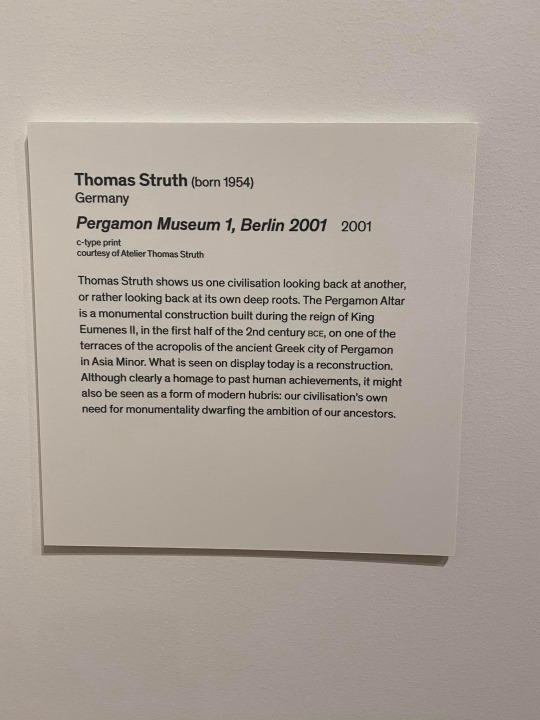

Pergamon Museum 1, Berlin 2001. Thomas Struth:
1.What is the cultural context of what you see in the image?
- People watching/ Spectating
- Surveillance
- Germany
- Ancient Greek
- Civilisation
- History
- Museum
2.What technologies are apparent in the image?
- Lighting
- Craftsmanship
3.What creative practices can you name in the context of this image?
- Construction
- Sculpture
-


Vista Aerea de la Ciudad de Mexico, XIII. Pablo Lopez Luz:
1.What is the cultural context of what you see in the image?
Overpopulation
Mexico
Civilization
Dystopian
Urban space
2.What technologies are apparent in the image?
- Aircraft
3.What creative practices can you name in the context of this image?
- Aerial Photography
0 notes

